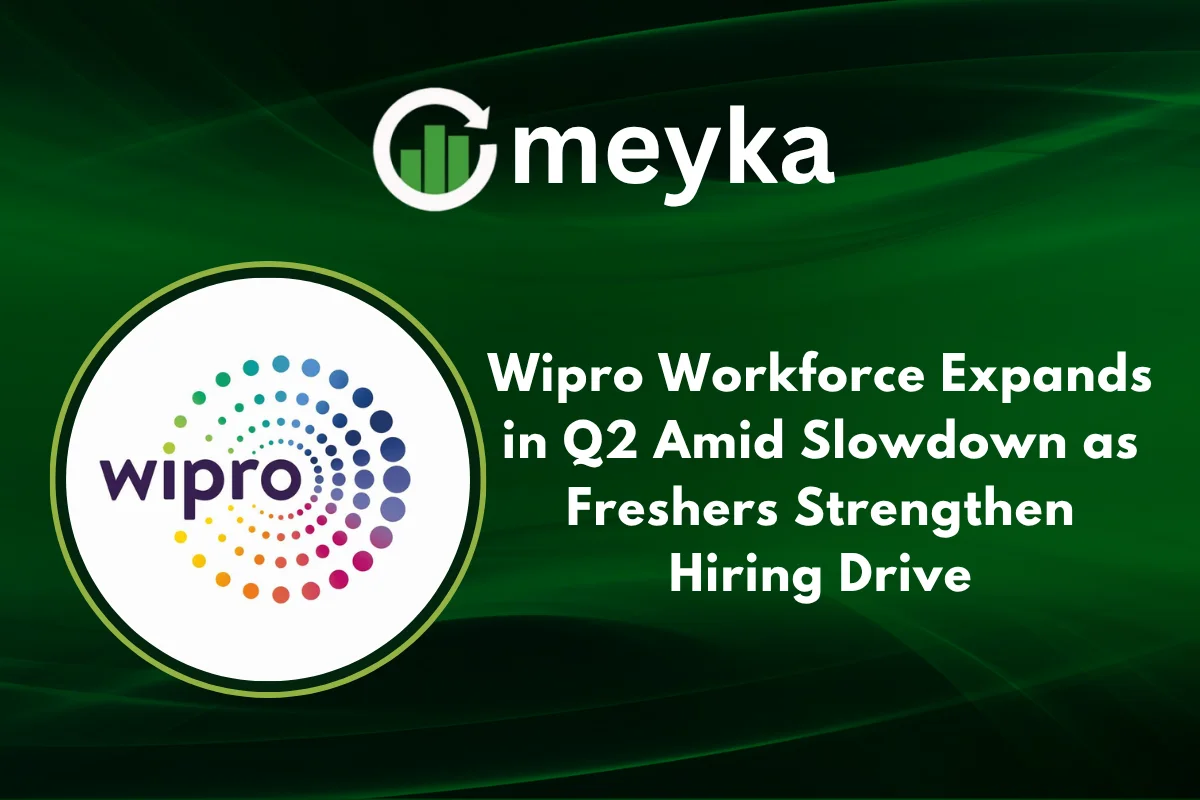Wipro Workforce Expands in Q2 Amid Slowdown as Freshers Strengthen Hiring Drive
In a challenging macroeconomic environment, Wipro Workforce numbers have shown a surprising uptick in Q2, driven largely by a renewed hiring push targeting fresh graduates. As the IT sector growth slows, Wipro’s strategic adjustments in talent acquisition and workforce planning stand out in a crowded field.
Overview of Wipro’s Q2 Workforce Expansion
During the second quarter, Wipro announced net employee additions after a period of relative stability. Reports suggest that while many technology firms froze or trimmed hiring, Wipro opted for a countercyclical move, building capacity early in anticipation of future demand. The Wipro Workforce expansion is not just a headcount increase; it’s a signal of confidence in future growth trajectories, especially in digital services and AI-driven transformation.
According to public filings, the majority of new hires were freshers, recent engineering and IT graduates, joining training pipelines rather than contributing immediately to revenue-generating projects. This approach helps Wipro maintain cost discipline while scaling up its bench strength.
Why Expand Workforce During a Slowdown? The Strategic Rationale
1. Future-Proofing Against Talent Scarcity
The IT sector is seeing increasing competition for top talent, especially in domains like machine learning, automation, cybersecurity, and cloud computing. By bringing in a new cohort of graduates, Wipro is ensuring a steady talent funnel for future needs. This helps avoid the premium wages and poaching risks that come with hiring later under pressure.
2. Lower Cost, Higher Flexibility
Junior hires carry lower initial costs. Wipro can train them internally in proprietary processes, frameworks, and domain knowledge. This gives the company flexibility to deploy them to projects over time without overspending on lateral hires.
3. Investing for Growth Areas (e.g., AI, Digital Services)
Wipro is positioning itself in next-generation services: generative AI, digital consulting, industry cloud solutions, and automation. Workforce growth supports these ambitions. A larger bench allows Wipro to allocate personnel to new verticals without disrupting existing client delivery.
4. Signaling Strength to Clients and Investors
An expanding workforce sends a message of confidence: Wipro believes opportunities are ahead despite current headwinds. For clients evaluating outsourcing partners, the message is that Wipro can scale rapidly. For investors watching AI stocks and tech equities, the move underscores Wipro’s long-term positioning.
Detailed Breakdown: Who’s Being Hired & Where
Freshers Are at the Core
The lion’s share of additions in Q2 were freshers in engineering, computer science, electronics, and related fields. These recruits undergo multi-month training in foundational skills, domain frameworks, and client tools. Some are later assigned to project teams; others remain in internal roles supporting R&D or tooling efforts.
Geographic & Business Unit Spread
To balance regional delivery capabilities, Wipro distributed hiring across key locations, tier-1 tech hubs, and emerging centers alike. The aim is to avoid overconcentration in metros, reduce salary inflation, and strengthen presence in satellite locations.
In terms of business units, new talent is being funneled into digital transformation, cloud services, AI/ML, cybersecurity, and enterprise solutions. Legacy services still get some resources, but growth headcount is skewed toward future-oriented verticals.
Attrition & Churn Management
While Wipro expanded, it also managed attrition carefully. Some voluntary exits occurred in legacy verticals or less growth-oriented roles. But Wipro’s HR teams focused on retention through reskilling and redeployment, keeping churn from undermining net growth.
Implications for Wipro’s Financials and Business Health
Short-Term Cost Pressure
An expanded workforce, particularly juniors in training, raises overheads before immediate revenue contributions. Wipro must absorb this cost, which may compress margins temporarily. But executives are likely banking on medium-term gains in utilization and revenue reallocation.
Future Revenue Leverage
Once the freshers transition into billable roles, the return on investment should kick in. Utilization rates rise, and Wipro can scale services without steep hiring costs at that stage. That kind of leverage is attractive for long-term profitability.
Competitive Positioning vs. Global Peers
In contrast to peers pulling back on hiring, Wipro’s workforce expansion gives it optionality. It can respond more nimbly to new client demands. If a rival lacks capacity, Wipro may seize share, especially in AI, cloud, and digital transformation contracts.
Investor Signal in AI Stocks & IT Sector Trends
For investors watching AI stocks and tech trend signals, Wipro’s move is a kind of contrarian bet: while many firms downsize, Wipro is doubling down on capability-building. This could hint that Wipro expects demand to rebound in AI/ML, automation, and enterprise cloud. For those doing stock research, Wipro’s strategy is a data point to track for conviction in longer-term growth.
Risk Factors & Challenges
Training & Ramp-Up Risk
Not all freshers will convert into fully productive employees. Some attrition, variability in learning curves, or mismatches to client needs are inevitable. Wipro must execute strong training, mentoring, and performance management to make this work.
Macro Demand Uncertainty
If the global economic slowdown deepens, client budgets could shrink further, reducing demand and placing pressure on utilization. Even large benches may sit idle if demand doesn’t return.
Margin Erosion
Until utilization is high across the board, margin pressure is real. Wipro must manage costs tightly, avoid overstaffing in non-revenue roles, and adjust hiring speed with market signals.
Competitive Leapfrogging
If rivals invest more aggressively in automation, low-code platforms, or specialized AI models, Wipro’s talent pipeline may not be enough. The firm needs to stay ahead on capability building, not just headcount.
Outlook: How Wipro Workforce Strategy Could Unfold
Over the coming quarters, we expect a few possible trajectories:
- Gradual Upside Realization
As cohorts mature and utilization rises, Wipro could see margin improvement, revenue growth, and higher client win rates, turning this hiring phase into a strategic advantage. - Hiring Moderation with Efficiency Focus
If demand stays weak, Wipro might slow freshers hiring, shift focus to high-margin projects, and emphasize productivity over expansion. - Selective Lateral Hiring + Reskilling
To accelerate key domains (e.g., AI product development), Wipro may bring in senior hires for leadership roles while continuing graduate onboarding. - M&A or Strategic Partnerships
Workforce expansion might pair with acquisitions or alliances, allowing Wipro to absorb specialized teams and fast-track capability in areas where fresh talent alone cannot suffice.
In all scenarios, Wipro’s ability to blend fresh talent with domain expertise, maintain client trust, and control costs will be central to success.
Conclusion
- Clients and partners see a Wipro poised to scale and invest in future domains rather than contract.
- Employees and aspirants will view Wipro as a destination for long-term growth and skill build-up.
- Investors can interpret this as a long-horizon play: short-term margin drag, but potential leverage if demand rebounds.
- Analysts of AI stocks and IT equity will track Wipro’s utilization, client wins, and new vertical traction as indicators of their thesis.
In sum, the Wipro Workforce expansion in Q2, led by freshers, represents a bold strategic move in a cautious industry climate. If executed well, it may pay dividends in capacity, domain strength, and competitive advantage.
FAQs
Hiring freshers lowers initial costs, allows internal training, and builds a long-term bench. It gives flexibility in staffing without paying high premiums for lateral hires.
Yes, in the short term. Training costs and lower utilization of new hires weigh on margins. The bet is that over time, utilization improves and revenue leverage kicks in.
Wipro is positioning itself to serve growth areas like AI, cloud, and digital transformation. For investors watching AI stocks and doing stock research, this move highlights Wipro’s confidence in future demand for tech services.
Disclaimer:
This content is made for learning only. It is not meant to give financial advice. Always check the facts yourself. Financial decisions need detailed research.






